
Robot Books
Content
HomeArticles
Gallery
Books
Lego
Personal
Links
Help
Books
Book ListRobot Books
James White
Terry Pratchett
Tom Holt
Larry Niven
Science Books
Miscellaneous Authors
This page contains the robot books I have.
- HERO 1: Advanced Programming and Interfacing
- Automatiseren met robots
- Advanced Robot Systems
- Vehicles: Experiments in Synthetic Psychology
- Het Robotboek
- Die Welt der Roboter
- De herschapen mens
- Denkende Machines
- Robot Builder's Bonanza
- Mobile Robots
- Behavior-Based Robotics
- The Unofficial Guide to LEGO MINDSTORMS Robots
- Applied Robotics
- Robo sapiens
- Build Your Own Robot
- Swarm Intelligence
- Robots
- Introduction to Autonomous Mobile Robots
- Ultimate Robot
- Radical Robots
- Growing Up with Lucy
- Robots: From Science Fiction to Technological Revolution
- Robot Shaping
- Service Robotor Visionen
- Flesh and Machines
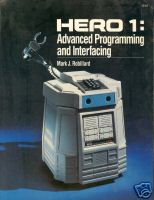
|
HERO 1: Advanced Programming and InterfacingMark J. Robillard - 1983ISBN 0-672-22165-9 |
Move to the world of the future today by learning all about the Heath HERO 1 robot. Learn to:
- Customize the HERO 1.
- Add extra memory and radio control.
- Add a removable keypad.
- Interface HERO 1 to a personal computer.
- Build a collision sensor and interface it to HERO 1.
- Program the robot with with machine language or a new higher-level language calles HEROPS.
- Use the "hidden" subroutines in the HERO 1.
- Tap the capabilities in the robot that are not explained in the technical manuals.

|
Automatiseren met robotsOntwerp en programmering van industriele robotsystemenChristian Blume, Rüdiger Dillmann - 1983ISBN 90-201-1603-7 |
Robots, vooral industriële robots, staant in het middelpunt van de belangstelling. Er is op dit gebied nog wiening in het Nederlands gepubliceerd waardoor er een zekere achterstand moet worden weggewerkt. Daarbij zal dit boek, dat op dit gebied uniek genoemd mag worden, zeker behulpzaam zijn. Voor ontwerpers en gebruikers van industriële robots, maar ook voor studenten die zich met dit onderwerp willen specialiseren, vormt dit boek een uitstekende basis. Er wordt in dit boek de nadruk gelegd op het programmeren van robots en op de daarbij gebruikte operating-systemen, waarbij echter als leidraad is genomen het totale systeem, met daarin de onderdelen manipulator, processor, sensors en periferie. Het boek is modulair opgebouwd, wat in dit verband wil zeggen dat de lezer een willekeurige keuze kan maken uit de hoofdstukken zonder beslist de volgorde van het boek aan te moeten houden.

|
Advanced Robot SystemsMark J. Robillard - 1984ISBN 0-672-22166-7 |
Anyone interested in the field of control or who wants to gain more knowledge about the exciting field of robotics needs this book. It provides advanced scientific information without heavy technical jargon and without heavvy emphasis on mathematics. In addition, the text
- Provides a step by step approach to the design of robots.
- Contains excellent flowcharts, examples, and walk-throughs to help in understanding the process behind designing robots.
- Defines the various problems that are encountered when completing a robotic system and shows some creative approaches for solving them.
- Covers both hardware and software design of systems.
- Details robot systems that move about on wheels, path guidance systems, high-level control of robot arms, and household or personal systems.
- Contains microprocessor applications in robotics.
The use of robots in industry and in the home will increase rapidly during the next few years creating many new oppertunities for those who are interested in robotics.

|
Vehicles: Experiments in Synthetic PsychologyValentino Braitenberg - 1984ISBN 0-262-52112-1 |
These imaginative thought experiments are the inventions of one of the world's eminent brain researchers. They are "vehicles", a series of hypothetical, self-oprating machines that exhibit increasingly intricate if not always successful or civilized "behaviour". Each of the vehicles in the series incorporates the essential features of al the earlier models, and along the way they come to embody aggression, love, logic, manifestations of foresight, concept formation, creative thinking, personality, and free will. In a section of extensive biological notes, Braitenberg locates many elements of his fatansy in current brain research.
"From Galileo to Einstein and Bohr, the tought experiments has provided a powerfull tool of scientific exposition. Its clarity and freedom from formalism give it an appeal other modes lack.
"The small and cheerfull book at hand, by a well-known researcher on the brain from Tubingen, has exploited the virtues of the style with unprecedented consistency, orgionality and aptness. His thought experiments are not analytic efforts to extract what principles lie behind an imagined observation but are instead synthetic constructions. They are little toys of the mind, devised out of simple if fictional components, entirely functionally described. ... (A) crisp, cogent book full of intellectual delights." - Philip Morrison, Scientific American

|
Het RobotboekChriet Titulaer, Henk Gosses - 1986ISBN 44-9010-1317 |
De Robotdag op 11 mei 1985 in Houten is een belevenis geworden die 50.000 bezoekers trok. Organisator Chriet Titulaer kwam bij de voorberijdingen a snel in contact met robotverzamelaar en beeldend kunstenaar Henk Gosses uit Leiden.
Sedert de robotdag voerden ze meerdere projecten samen uit, zoals de robot voor de show van Jasperina de Jong of de maanauto op Space '86. Het plan een boek over robots te maken is een gevolg van dat contact. De deskundigheid van de twee auteurs vult elkaar prima aan: Henk Gosses die schrijft over zaken als robots in de film, zelfbouwrobots en verzamelrobots.
Chriet Titulaer die schrijft over robot en computer, de industriele robot, robots in de ruimte en kunstmatige intelligentie. De robot wordt in dit boek op alle denkbare manieren bekeken. Een boeiend, visueel gebracht verhaal dat zeker een glimlach zal oproepen.

|
Die Welt der RoboterBrian Morris - 1986ISBN 3-524-69058-0 |
Eine Einfuhrung in die Welt der computergesteuerten Madchinen von der griechischen Sagenwelt bis ins dritte Jahrtausend.
Aus dem Inhalt:
- Wie Roboter funktionieren
- Die Sinne des Roboters
- Roboter-Gehirne, im wesentlichen Computer und Mikroprocezessoren - wie functionieren sie?
- Ausgefallene Roboter
- Werbe-Roboter
- Roboter im Hauhault
- Roboter-Patienten
- Science-Fiction-Roboter

|
De herschapen mensDe robot wordt werkelijkheidIgor Aleksander, Piers Brunett - 1986ISBN 90-274-6255-0 |
In dit bijna futuristische boek, dat echter tot stand kwam op grond van diepgaand wetenschappelijk onderzoek, wordt voorspeld dat men in de toekomst zelfdenkende robots zal kunnen vervaardigen. De huidige robots zijn weliswaar uitstekend in staat een reeks voorgeprogrammeerde handelingen volgens een bepaald vaststaand patroon te verrichten, maar van echt met het menselijke brein te verglijken intellect is nog geen sprake. Men kan een robot bijvoorbeeld wel leren schaken op het niveau van een grootmeester, maar niet zelf door elkaar gegooide schaakstukken laten uitzoeken. Binnen afzienbare tijd, zo voorspellen echter de auteurs van dit verbazingwekkende boek, zal men een robot ontwikkelen die zelf kan nadenken, zien, horen en handelen op grond van ervaringsfeiten. De razendsnelle ontwikkelingen van de elektronica technieken doen verwachten dat de structuur van de hersenen wel degelijk 'nagebouwd' kan worden. Dergelijke robots spreken geen computertaal, maar antwoorden de gebruiker in zijn eigen omgangstaal... De robot als reële concurrent of campagnon? De robot als proef persoon voor experimenten? Een ontwikkeling om terdege op voorbereid te zijn...

|
Denkende Machinesop zoek naar kunstmatige intelligentieIgor Aleksander, Piers Brunett - 1987ISBN 90-269-4428-4 |
Al meer dan dertig jaar trachten onderzoekers machines te ontwerpen die kunnen denken. Maar zullen ze er ooit komen, die denkende machines? De meningen zijn verdeeld. Het belangrijkste probleem op zoek naar kunstmatige intelligentie lijkt te zijn dat men er tot op heden nog niet in is geslaagd machines te creeren die kunnen leren.
In 'Denkende machines' leggen Igor Aleksander en Piers Burnett uit waarom er tot op heden nog steeds geen definitieve doorbraak op het gebied van de kunstmatige intelligentie heeft plaatsgevonden. Aan de hand van duidelijke illustraties die werden ontworpen op een van de modernste CAD-machines en in taal die ook voor computer-analfabeten te begrijpen is, zetten zij uiteen hoe computers werken, hoe ze geprogrammeerd worden en waarom ze op dit moment nog niet kunnen denken als mensen.
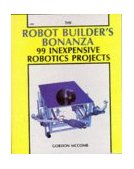
|
Robot Builder's Bonanza99 Inexpensive Robotics ProjectsGordon McComb - 1987ISBN 0-8306-2800-2 |
Hou you can build and combine all the various parts that make up a robot ... to create your own origional, custom-designed, personal robot.
"This 'cookbook' approach proposes educational but fun designs for constructing robots of all shaoes, sizes and abilities." - ALA's Booklist
"Offers a unique collection of fully tested project modules that can be mixed and match in countless combinations. The reader's imagination is the other ingredient required for the creation of highly intelligent, one-of-a-kind, working robots." - Popular Electronics
"... If you love using your hands and your brain, you will find much pleasure from this book of mechanics and electronic circuits." - Practical Electronics

|
Mobile RobotsInspiration to ImplementationJoseph L. Jones, Anita M. Flynn - 1993ISBN 1-56881-011-3 |
With the implementation of their new book, Mobile Robots: Inspiration to Implementation, the authers hope to impart their youthful outlook and experience in conceptualizing and creating robots to anyone interested in robotics. Their aim, put simply, is to teach the reader how to build a robot. However, they hope not only to expand the imagination of a generation of robotics enthusiats but also supply them with the requisite skills and tools to implement their dreams. The recent wide availability of home computers and the dradtic reduction in the cost of microelectronics has put this goal well within reach. This book now puts it onder one cover.
A melange of illuminating photographs, illustration, and accessible text, Mobile Robots guides the reader through the step-by-step process of constructing two different, inexpensive and yet fully functional robots with a varying range of abilities. More importantly, though, the book is designed to be just a starting ground for later creating the robot of your dreams.
The book is being used with tremendous success by educators such as those at Wellesley High School, Vassar College, and MIT, but you don't have to be a student to glean th authors' knowledge of robotics and artificial intelligence. Learning is a constant process and this book is designed to be amendable to as broad an audience as possible, from university professor to basement tinkerer.
They say that we don't really grow up, that the toys just get more sophisticated. Maybe this book will prove them absolutely right!
"Mobile Robots has been the key to starting in-depth robotics course work at Wellesley High School." - Bruce Seiger, Don McAleer (Wellesley High School)
"There is not, to my knowledge, anything else like it on the market and I would recommend it most highly to anyone wishing to learn basic concepts in robotics." - Kenneth R. Livingston (Vassar College)
"This book is a 'must have' collection of information, pointers, and concepts for the robotics hobbyist. It answers a lot of prayers/questions from the amateur robotics world." - Karl Lunt
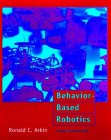
|
Behavior-Based RoboticsRonald C. Arkin - 1998ISBN 0-262-01165-4 |
This introduction to the principles, design, and practice of intelligent behaviour-based autonomous robotic systems is the first true survey of this robotics field. The author presents the tools and techniques central to the development of this class of systems in a clear and thorough manner. Following a discussion of the relevant biological and psychological models of behaviour, he covers the use of knowledge and learning in autonomous robots, behaviour-based and hybrid robot architectures, modular perception, robot colonies, and future trends in robot intelligence.
The text throughout refers to actual implemented robots and includes many pictures and descriptions of hardware, making it clear that these are not abstract simulations, but real machines capable of perception, cognition and action.
Ronald C. Arkin is Professor in the College of Computing at Geargia Institute of Technology.
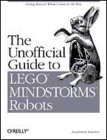
|
The Unofficial Guide to LEGO MINDSTORMS RobotsJonathan B. Knudsen - 1999ISBN 1-56592-692-7 |
In 1998, The LEGO Group introduced the MINDSTORMS Robotics Invention System. This set makes it possible for you - wether you're 12, 35, or 75 - to affordably build and program robots for fun. You know it's a very cool toy, but you might be wondering, "Where can I go from here? How can I get the moist out of this set?"
The Unofficial Guide to LEGO MINDSTORMS Robots shows you how to take your robots to the next level. This book is a hands-on guide to getting the most out of your robot building experience. It goes far beyond the stuff you get in the Robotics Invention System.
Here you'll learn how to use alternative programming environments like NQC, pbFORTH, and legOS to develop powerful software for your robots. Along the way, the book gives you many hints for builing better robots. It includes mechanical tips, such as how to build a directional transmission, and different strategies for making your robot move. It also covers software tips, such as how to use subsumption architecture and how to use one input to read more than one sensor.
The Unofficial Guide to LEGO MINDSTORMS Robots includes five construction projects. Build, program, play, and leran from them; you can even change and add to them. This book also contains pointers to many Internet resources, a list of place to get parts, and instructions for how to build your own sensors.
Take the Robotics Invention System, use the tools and tricks described in this book, and stretch your imagination. Build. Program. Have a blast!
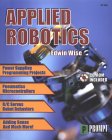
|
Applied RoboticsEdwin Wise - 1999ISBN 0-7906-1184-8 |
There's a little mad scientist in all of us. When it comes out, some interesting and sometimes brilliant thing can occur. Quite possible, a robot with realistic behaviors and senses could come rolling out of the labratory of your mind.
With Applied Robotics, you can fulfill your dreams of building a simple robot that reacts, moves, and behaves much like the larger, more advanced systems you've seen working in manufacturing plants and guarding the hallways of warehouses.
This book is designed to give the beginner a thorough and complete introduction into the field of robotics with simple projects and easy-to-read explanations. Detailed and extensive schematics, programs, and descriiptions guide you through the challenges of building a working robot. You'll be introduced to all the issues surrounding robotic systems, including mechanical design, sensory systems, electronic control, and computer software intelligence. Along the way, you'll also learn about Fuzzy Logic and microcontroller systems, including serial and memory-mapped interfacing.
Applied Robotics will have you building your own robot in no time; and who knows, maybe the knowledge you gain will help you build the next, more-advanced generation of robots walking, talking, and moving throughout the world.
About the Author:
Edwin Wise develops CAD/CAM software during the day, and explores the edges of mad science at night. He has written game software for Broderbund and Dynamix and manufacturing software for Point Control and Building Blocks, but always returns to his interest in robots and simulated intelligence after-hours. He is currently building a giant pneumatic robot named Boris, and looks forward to many more years of mad projects.
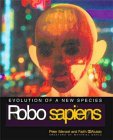
|
Robo sapiensEvolution of a new speciesPeter Menzel, Faith D'Aluisio - 2000ISBN 0-262-13382-2 |
"This is one of the most mind-stretching -and frightening- books I've ever read. It's also a tour the force of photography: the images reveal a whole new order of creation about to come into existence. No one who has any interest in the future can afford to miss it." - Sir Arthur C. Clarke
"An engaging and insightful compendium illuminating our accelerating ascent to the inevitable merger of human and machine. Altough many today find the prospect disconcerting, by the time the Robo sapiens are fully amongst us, we will find it very natural to interact intimately with these inventions of our intellect." - Ray Kurzweil
"You pick up Robo sapiens for the great photos, and then get caught up reading the inside politics of the race to build humanlike machines. Don't be suprised by the comming era of robotics --- read Robo sapiens and be ready." - K.Eric Drexler
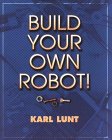
|
Build Your Own RobotKarl Lunt - 2000ISBN 1-56881-102-0 |
This book, a compilation of articles from Karl Lunt's longrunning column for Nuts and Volts magazine, is a must-read for all beginner and intermediate-level robotics enthusiasts. Written is a friendly, straightforward manner, it contains practical advise and instruction as well as entertaining anecdotes. The author's stories about his various robotics projects will inspire you to try them yourself - and he shares his tips and code to help you. Possible project range from tranforming a TV remote control into a robot controller to building a robot from a drink cooler. You'll want to build them all - the author's enthusiasm for robotics is contagious!
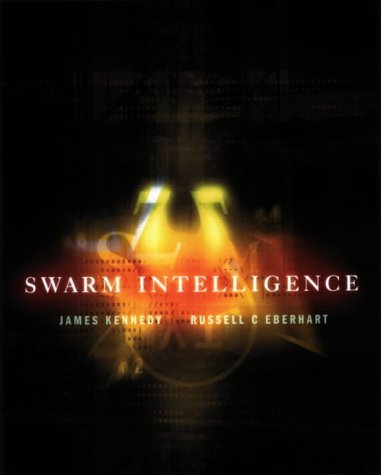
|
Swarm IntelligenceJames Kennedy, Russel C. Eberhart, Yuhui Shi - 2001ISBN 1-55860-595-9 |
Swarm Intelligence argues that inteligent human cognition dervies from the interactions of individuals in a social world and that the sociocognitive view can be effectively applied to computationally inteligent systems. This interdisciplinary work draws on findings in social-psychological and engineering research to derive a family of optmization algorithms that shed light on human information processing as well as providing tools for numerical and qualitative optimization. Particle swarm optimization (PSO) is an entirely new kind of social intelligence model to be recast as an optimization, learning, and problem solving method, thus establishing its importance as a milestone.
This important book presents valuable new insights by exploring interdisciplinary bounderies an by applying these insights to the solving of difficult engineering problems. Researchers and graduate students in social and computer science will find the material intriguing, provocating, and revealing, as will the savvy computing professional.
Features:
- Places particle swarms within the larger context of intelligent adaptive behavior and evolutionary computation.
- Descripes recent results of experiments with the PSO algorithm.
- Includes a basic overview of statistics to ensure readers can properly analyze the results of their own experiments using the PSO algorithm.
- Provides links to support software that can be downloaded from the publisher's web site. Includes a Java PSO applet, and C and Visual Basic source code, as well as links to numerous related web sites.

|
RobotsClive Gifford - 2004ISBN 90-257-3797-8 |
Ga op ontdekkingsreis met Gottmer Jong Geleerd.
In de serie lees je alles over jouw favoriete onderwerpen en kom je veel te weten over de wereld om je heen. De schitterende foto's laten je alles zien, tot in het kleinste detail. Met de leuke knutselprojecten en proefjes achter in elk boek kun je meteen aan de slag!
Ontdek nu alles wat je altijd al wilde weten over robots!
- Bewonder de reuzenrobotarm die vliegtuigen wast.
- Kijk hoe de machtige Robosaurus een auto in tweeën breekt.
- Ga op spionagetocht met de robotspion.
- Lees alles over robothuisdieren.
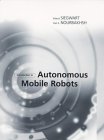
|
Introduction to Autonomous Mobile RobotsRoland Siegwart, Illah Reza Nourbakhsh - 2004ISBN 0-262-19502-X |
Mobile robots range from the teleoperated Sojourner on the Mars Pathfinder mission to cleaning robots in the Paris Metro. Introduction to Autonomous Mobile Robots offers students and other interested readers an overview of the technology of mobility - the mechanisms that allow a mobile robot to move through a real world environment to perform its tasks - including locomotion, sensing, localisation and motion planning. It discusses all facets of mobile robotics, including hardware design, wheel design, kinematics analysis, sensors and perception, localisation, mapping and robot control architectures.
The design of any successful robot involves the integration of many different disciplines, among them kinematics, signal analysis, information theory, artificial intelligence and probability theory. Reflecting this, the book presents the techniques and technology that enable mobility in a series of interacting modules. Each chapter covers a different aspect of mobility, as the book moves from low-level to high-level details. The first two chapters explore low-level locomotory ability, examining robots' wheels and legs and the principles of kinematics. This is followed by an in-depth view of perception, including descriptions of many "off-the-shelf" sensors and an analysis of the interpretation of sensed data. The final two chapters consider the higher-level challenges of localisation and cognition, discussing successful localisation strategies, autonomous mapping and navigation competence. Bringing together all aspects of mobile robotics into one volume, Introduction to Autonomous Mobile Robots can serve as a textbook for coursework or a working tool for beginners in the field.
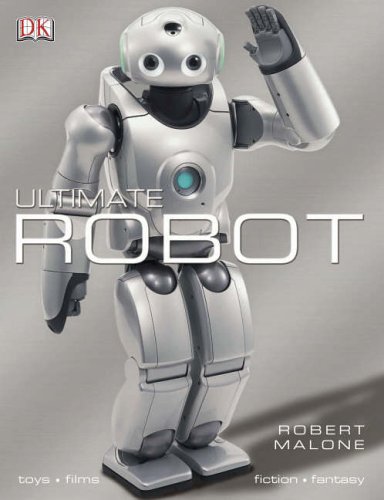
|
Ultimate RobotDorling Kindersley - 2004ISBN 0-75137-3613 |
Do you know Transformers from the Terminator? Blending science fiction with science fact, this is the ultimate guide to every kind of robot. Covering all types of makes and models - from celluloid classics to tin toys and the latest Japanese cyborg, this is a must for all those "boys" who are mad about the 'bot!

|
Radical RobotsCan You Be Replaced?George Harrar - 1990ISBN 0-671-69420-0 |
When someone uses the word robot, people often think of 3CPO from the movie StarWars. But he was only an actor in robot costume. A true robot might be a mechanical arm doing assembly-line work, or it could be a very complex machine with siz legs, X-ray vision, and a computer for a brain. There are robots that can add and divide huge sums instantly, play chess like champions, and explore space. But even the best of the super robots cannot create a poem, ride a bicycle down the street, or recognize themselves in a mirror. This book is not juat about robots, or even super robots. Radical Robots explains the similarities and striking differences between the human brain and intelligent machines, and points out that people are creating the robots - the robots are not making people! The book contains an intriguing assortment of robot photographs (including some of movie fame), as well as many humorous drawings showing the possibilities of a robotic future.
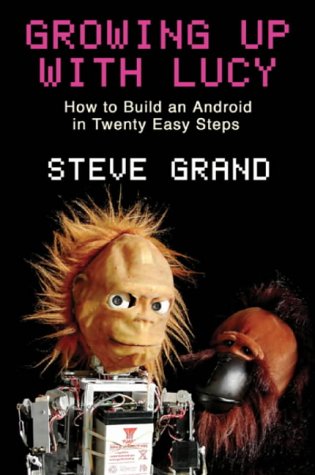
|
Growing Up with LucyHow to Build an Android in Twenty Easy StepsSteve Grand - 2004ISBN 0-297-60733-2 |
The inside story of the most intelligent robot in the world.
Steve Grand has spend the last three years trying to build an artificial intelligent android. Steve is a self-taught scientist who has deliberatly eschewed large public grands and laboratory affiliation to give himself as much freedom as possible to put his revolutionary theories on artificial intelligence to the test. The result is Lucy, still a work in progress yet already one of the most advanced research robots in existence - hersuccesses and failures stand as indicators of the present state of robotics.
The compelling story of Lucy's creation, all done in Steve's own home, is a fascinating mixture of human perseverance and cutting-edge scientific endeavour. We share in the frustration and elation of Steve's daily battles with Lucy's emerging 'brain', especially as he closes in on the major breakthrough he's been waiting for.
Steve Grand's work makes us question what it means to be human, and the birth of Lucy has massive implications for us all.
Steve Grand is the inventor of the groundbreaking artificial life computer game 'Creatures'. He is a NESTA Fellow, and also holds honorary research fellowships in psychology at the University of Cardiff and biomimetics at the University of Bath. He was nominated by the Sunday Times as one of 'The Brains Behind the 21st Century', and received an OBE in the millenium honours list for his contributions to the computer games industry. His previous book, Creation: Life and How To Make It, was shortlisted for the 2001 Aventis Prize.

|
Robots: From Science Fiction to Technological RevolutionDaniel Ichbiah - 2005ISBN 0-8109-5906-2 |
Robots in one form or another heve engaged the popular imagination for centuries. Now, on the cusp of the twenty-first century, they are poised to saturate every aspect of our culture, from medicine, science, and industry to artwork, toys, and household appliances. Wheter playing prominent roles in movies like 'I, Robot' or helping mankind eplore the surface of Mars, robots seem to be taking over the world. Robots is the first visual survey to focus on this increasingly important, always newsworthy scientific development and its effect on society.
Covering automatons, androids, and all manner of artificial intelligence, both fictional and real, this massive, comprehensive volume describes the robot's fascinating history and speculations on its probable future. Interviews with scientists, surgeons, manufacturers, science fiction writers, artists, toy creators, and a host of other experts bring tremendous insight to the subject, and the copious illustrations provide visual examples of robots in every environment imaginable. As entertating as it is informative, this one-of-a-kind book is an indispensable guide to the rapidly approaching Robot Age.
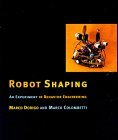
|
Robot ShapingAn Experiment in Behaviour EngineeringMarco Dorigo, Marco Colombetti - 1998ISBN 0-262-04164-2 |
Programming an autonomous robot to act reliably in a dynamic environment is a complex task. The dynamics of the environment are unpredictable, and the robots' sensors provide noisy input. A learning autonomous robot -one that can acquire knowledge through interaction with its environment and then adapt its behaviour- greatly simplifies the designer's work. A learning robot need not be given all of the details of its environment, and its sensors and actuators need not be finely tuned.
Robot Shaping is about designing and building learning autonomous robots. The term "shaping" comes from experimental psychology, where it describes the incremental training of animals. The authors propose a new engineering discipline, "behaviour engineering," to provide the methodologies and tools for creating autonomous robots. Their techniques are based on classifier systems, a reinforcement learning architecture originated by John Holland, to which they have added several new ideas, such as "mutespec", classifier system "energy", and dynamic population size. In the book they present Behaviour Analysis and Training (BAT) as an example of a behaviour engineering methodology.

|
Service Robotor VisionenRolf Dieter Schraft, Marting Hägele, Kai Wegener - 2004ISBN 3-446-22840-3 |
Holt uns die Welt der Science Fiction bald ein? Wie weit ist die Robotik den Fabrikhallen entschlüpft? Was hat der Stand der Forschung und Technik zu bieten? Wie werden wir schon heute, aber auch in Zukunft von Robotern beeinflusst? Müssen wir vor intelligenten Machinen Angst Haben?
Diese und andere Fragen werden mit dem vorliegenden Buch beantwortet. Dabei wird in anschaulicher Weise, ausgehend von aktuellen Forschungsergebnissen über Demonstratoren, Prototypen, Produkten bis hin zu Kuriositäten und Visionen der weltweite Stand gespiegelt. Das Buch erhebt allerdings keinen Anspruch auf Vollständigkeit, es soll dem Leser viel mehr einen Eindruck vermitteln, was im Bereich der Robotik aktuell diskutiert wird und was wir in Zukunft zu erwarten haben.
Dieses Buch richtet sich an Leser, die sich einen Überblick über die vielfältigen Arbeits- und Anwendungsgebiete der Servicerobotik und den Stand der Technik und Forschung verschaffen möchten. Darüber hinaus wird über spezielle Schlüsseltechnologien der Servicerobotik informiert. Das Buch setzt dabei kein spezielles technisches Grund- und Vorwissen voraus.
Vielmehr wird dem Leser ermöglicht, sich abhängig von seinen Interessen unterschiedlich tief in die Materie und das jeweilige Themengebiet einzulesen.
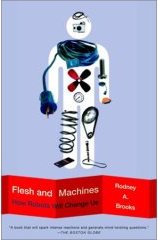
|
Flesh and MachinesHow Robots Will Change UsRodney A. Brooks - 2002ISBN 0-375-42079-7 |
"A stimulating book written by one of the major players in the field - perhaps the major player. . . . Offers surprisingly deep glimpses into what it is to be human." -The New York Times Book Review
Are we really on the brink of having robots to mop our floors, do our dishes, mow our lawns, and clean our windows? And are researchers that close to creating robots that can think, feel, repair themselves, and even reproduce?
Rodney A. Brooks, director of the MIT Artificial Intelligence Laboratory believes we are. In this lucid and accessible book, Brooks vividly depicts the history of robots and explores the ever-changing relationships between humans and their technological brethren, speculating on the growing role that robots will play in our existence. Knowing the moral battle likely to ensue, he posits a clear philosophical argument as to why we should not fear that change. What results is a fascinating book that offers a deeper understanding of who we are and how we can control what we will become.
"Brooks . . . lucidly explores his life with robots.... Flesh and Machines ranges far and wide, but remains unified by the author's passion." -Wired
"Readers don't have to share Brooks' vision of the future to love reading his book, the imaginative work of a skilled yet genial provocateur." -Pittsburgh Post-Gazette